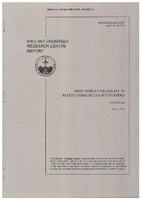Time series variability in fluctuating ocean waveguides

Abstract
The variability of signals propagating through an uncertain sound speed structure is addressed. Signals are assumed to travel in a narrow band adiabatically in modes and to experience fluctuations in sound speed which are characterized according to the vertical and horizontal distributions of these fluctuations. The sound speed fluctuations are assumed to affect only the phase speed and the group speed of the modes in a perturbative way. The changes in the local phase and group speeds are expanded for small perturbations to the sound speed. Sound speed perturbations are described in terms of their statistical characteristics. Vertically, the sound speed fluctuations are decomposed into empirical orthogonal functions (EOFs), while horizontally they are assumed to be correlated on some horizontal length scale much smaller than the propagation ranges of interest. Thus the cumulative phase and group speed fluctuations over the propagation path are assumed to be distributed Gaussian according to thecentral limit theorem. The framework outlined above is used to derive the first and second moments of the signal envelope received over an ensemble of ocean realizations following the distribution properties outlined above. Since the mean and variance of the expected signal are obtained in the time domain, the stability of modal arrivals in time can be predicted for a variety of different sound speed fluctuation distributions. Since the phase and group speed fluctuations are linear in identical terms involving the inner product of the mode shape functions with the EOFs, the fluctuations of these quantities are entirely correlated. However, as the different EOFs express themselves differently on each set of propagating modes, the modal interference structure becomes less certain due to the fluctuations. The theory estimates this degree of decorrelation as a function of the signal, waveguide and fluctuation parameters. In order to benchmark the theory, the first moment of the short time average of the signal intensity is also predicted using realizations of propagation through an ensemble of sound speed fluctuations consistent with the statistical description. Excellent agreement is found between these self-consistent Monte-Carlo estimates of the signal variability and the closed form expressions.
Report Number
SR-319Date
1999/07Author(s)
LePage, Kevin D.